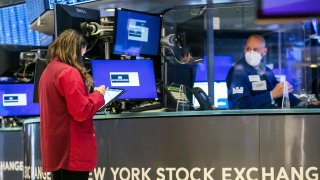
The Federal Reserve, which has played a big part in confusing the markets, may be helping to clear things up.
What happened to the argument that inflation would blow up bond yields? So far, it has been wrong.
With bond yields lower, not higher, the bond market is signaling it's more worried about weaker growth, not inflation. And the Fed is the cause of that.
Apoplectic investors: What's going on?
Feeling out of the loop? We'll catch you up on the Chicago news you need to know. Sign up for the weekly Chicago Catch-Up newsletter here.
A lot of apoplectic investors are twisting themselves into pretzels these days, trying to understand what's going on in the markets.
Inflation hawks are having a tough time explaining why, now that the Fed has finally upgraded its inflation expectations, bond yields have been dropping.
Money Report
"Now we have a Fed that really wants to encourage it [inflation]," rate watcher Jim Grant said on CNBC recently. "So, we are doing in public policy what we have never done before, and in these circumstances, the chairman of the Federal Reserve is kind of sanguine. I think it's kind of striking."
Value investors — banks, industrials, commodity stocks and other cyclicals — who have enjoyed five months of outperformance after years of lagging the market are apoplectic that the market is selling off commodity stocks as fast as they can.
And technology and growth investors, particularly those in speculative growth stocks championed by Cathie Woods and others, are delighted as her flagship fund, ARK Innovation ETF (ARKK), is at its highest level since early May after getting pummeled from February through April.
Others, however, are hopeful some of the confusion may be coming to an end.
"The Fed has regained control of the inflation narrative," Pimco's Tony Crescenzi said on CNBC.
Here's why traders are so confused
Are bond yields trending up or down? Should we buy cyclical stocks or technology stocks or defensive stocks? Is the economy still on a tear that is going to last into 2022, or are we cooling off fast? Is inflation such a problem it's going to become 1974 again, or is it going to become perfectly manageable in a few months?
It's understandable everyone is confused. The shock of Covid, the sudden bust and subsequent boom, combined with massive liquidity from the Federal Reserve, has confused everyone on where we are in the economic cycle.
Early stage? Middle stage? Late stage? Stagflation? Deflation? Inflation?
If the economy is still in an early stage of the economic expansion, investors would typically buy cyclical (value) and bank stocks.
If the economy is in the middle of the recovery, in which growth and earnings are still strong but beginning to decelerate and interest rates are still low, investors would typically favor technology stocks.
If the economy is in a late-cycle phase, which is characterized by higher rates and higher inflation and high price-earnings ratios, investors would typically favor defensive sectors like consumer staples.
The problem is, no one is sure what part of the economic cycle we're in. That's why we go up and down, and in and out, of different sectors every day.
Traders call this rotation. But this is much more than rotation. This borders on schizophrenia.
The Fed to the rescue?
Perhaps the Fed, which in an effort to aid the economy created much of this confusion, can help bring more order.
The number one driver of the market has been monetary policy. The oceans of liquidity provided by the Federal Reserve created an enormous economic boom that argued for buying value (cyclicals) over growth (technology, health care). That approach was successful through the first five months of the year.
Now that is reversing because the markets believe the Fed will slow the economy in 2022, so bond yields are going down because of fears of slower growth and cyclical stocks like Caterpillar, Freeport-McMoRan, and U.S. Steel are getting clobbered. Investors are going back into dependable growth (technology) that is less dependent on the economic cycle.
Cynics will argue that this is just the narrative for the moment that could change on a dime. But the Fed, which created much of this confusion, is now acting in a manner that is causing traders to map out a clearer economic scenario. It is one of still-strong growth but with less monetary accommodation and slightly higher short-term rates some time next year.
The market is saying that in this case, less liquidity rather than inflation worries is the primary near-term driver of the market.
So where are we in the market cycle?
"Market pricing is consistent with the midcycle average, which suggests there is some time to go," Crescenzi said. "For now, it looks like the runway is clear, in part because the economic story is very good." He forecasts economic growth next year to remain "above long-term trends."
But the inflation hawks, many of whom have been at war with the Federal Reserve since President Franklin Delano Roosevelt took the United States off the gold standard in 1933, are undeterred.
"I think what we tend to forget is these are very low rates and very high valuations dangling on the thread of these low rates," Grant said. "I think what the Fed, in effect, said is it's going to give inflation a nice running start, and it will catch up at length. And that is a strategy that failed in the 1960s and I'm not sure how it succeeds today."






